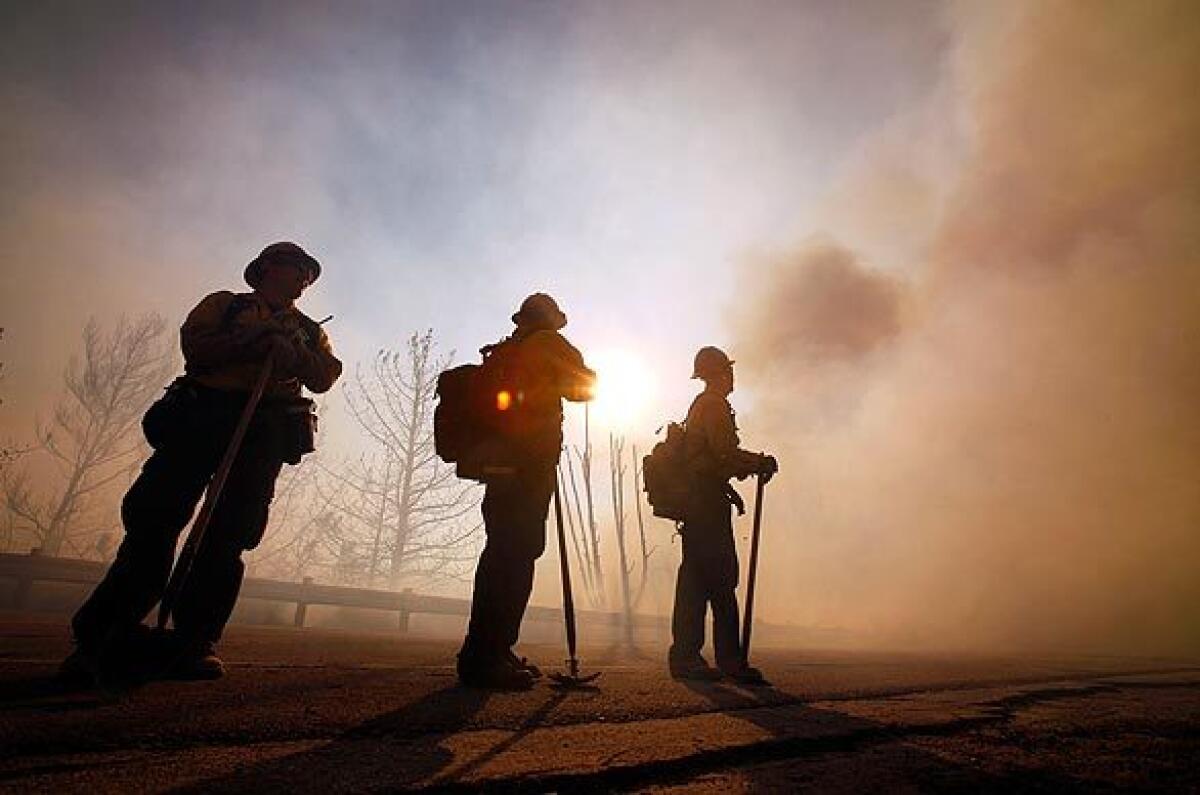Federal fire policies questioned

- Share via
Sharply questioning the U.S. Forest Service’s aggressiveness, the Los Angeles County Fire Department says in a report on the deadly Station fire that the federal agency should change its policies to allow night flying by water-dropping helicopters and make greater use of local reinforcements to attack any blaze in the Angeles National Forest.
In the report, a review of the first five days of the Station fire, County Fire Chief P. Michael Freeman urges the Board of Supervisors to lobby the U.S. Department of Agriculture and Congress to alter the Forest Service’s practices to ensure “a timely appropriate response to wildfires” in the Angeles.
The report suggests that a fiercer air assault by the Forest Service -- and by the county at one crucial point -- might have kept the Station fire small.
It says the Forest Service must change its approach from “taking what the fire will give us” -- a defensive posture -- to “hitting the fire early and hard.”
In a statement late Wednesday, the Forest Service hit back, saying the county did not voice such concerns during the federal agency’s internal review of the Station fire, an inquiry joined by officials from the county and state Department of Forestry and Fire Protection. A Forest Service report last week said its review found that the agency used “best professional practices” in responding to the fire, which started Aug. 26.
“L.A. County did not raise these issues during our review,” the Forest Service said in Wednesday’s statement. “We stand by our report.”
Unlike the county and Los Angeles city fire departments, the Forest Service does not deploy water-dropping aircraft at night, because of safety worries. County helicopters helped contain the Station fire to 15 acres during its first day, after it broke out at the edge of the forest above La Canada Flintridge. Because the fire was burning on federal land, the Forest Service later took control and the choppers were sent home.
After Forest Service commanders rolled back their response, the fire began to spread overnight, and no helicopters returned until about two hours after first light on the critical second day, The Times has reported.
“Would night flying have made a difference? No one can say for sure, but night flying is a policy change that is needed,” the county report says. “A robust air attack at first daylight is another tactic that can make a difference.”
The report adds that county commanders “should have been more assertive” and dispatched their own helicopters to the fire at first light on Day 2, even though the blaze was under federal jurisdiction.
Freeman said in an interview that he was not advocating “mutiny” against the Forest Service, but that his officers should be prepared to call in aircraft if they believe a fire would eventually imperil county territory. “I want to see things tried,” he said.
The Times has reported that the county rejected a Forest Service request for two helicopters later on the second day, sending only one. The report does not examine that decision, which Freeman said would be explored in subsequent analyses of the firefighting effort.
The report says that county helicopters were diverted from the Station fire to a Palos Verdes blaze on Day 2.
Freeman said that “wasn’t a mistake,” because at the time the Palos Verdes fire posed a more immediate threat to homes.
Three weeks before the Station fire, Forest Service supervisors were ordered to reduce reimbursement costs by minimizing their use of local and state aircraft and ground crews.
The Forest Service brought in fewer county helicopters and firefighters on the second day of the blaze, but has denied that money influenced its decision.
In last week’s report, the Forest Service concluded that helicopters would not have helped during the early morning hours on Day 2, because the fire was burning in terrain too steep for ground crews to take advantage of water drops. But that finding has been challenged by local officials and firefighters who were at the scene.
The blaze killed two county firefighters, burned 250 square miles of the forest, destroyed nearly 100 dwellings and cost about $90 million to fight.
The report offers few new details about the deaths -- Ted Hall and Arnie Quinones were killed when their truck plunged off a canyon road -- and notes that a state investigation into the fatalities is underway.
Among the other recommendations is that the Forest Service allow commanders on the front line to order more equipment without first telephoning the agency for permission.
In addition, the report says the Forest Service should adopt the county’s standard for clearing brush to at least 200 feet from around homes and other structures, including the communications towers at Mt. Wilson. The Forest Service requires a 30-foot clearance.
The historic Mt. Wilson installations had been threatened during much of the Station fire.
--
More to Read
Sign up for Essential California
The most important California stories and recommendations in your inbox every morning.
You may occasionally receive promotional content from the Los Angeles Times.











